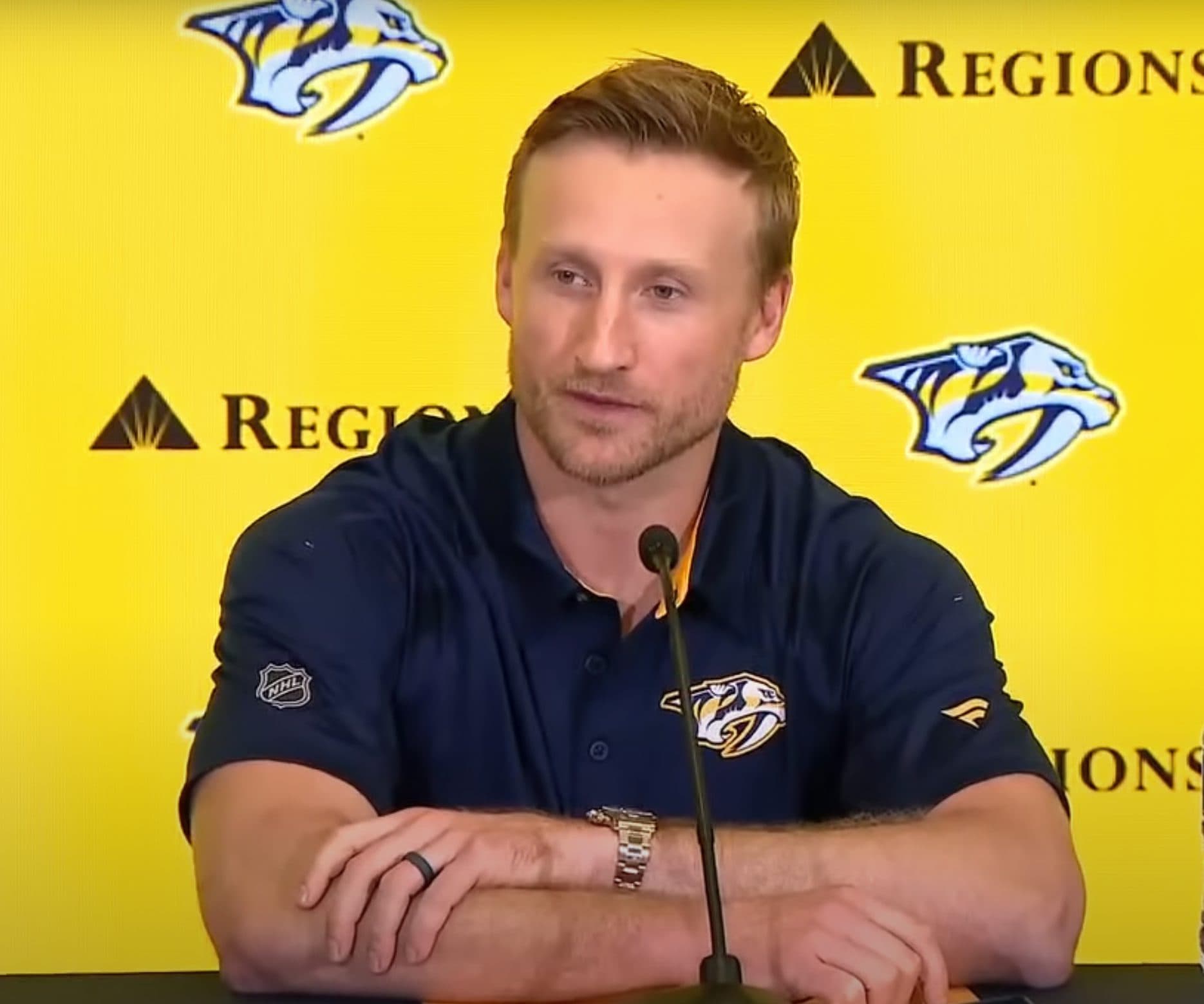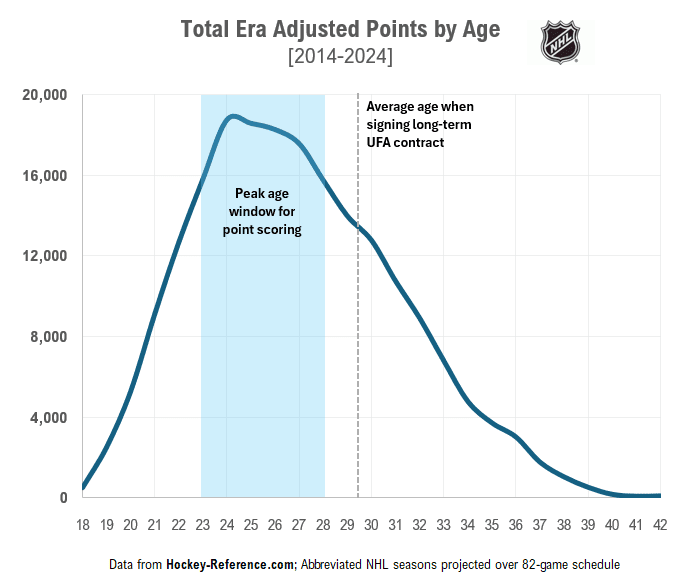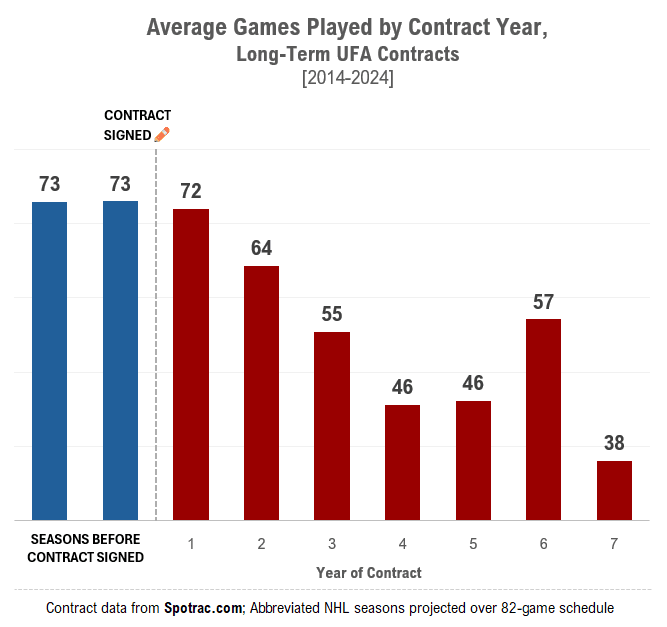Most long-term UFA signings turn out even worse than you think

The week of July 1 is a rare window for NHL franchises to immediately improve.
In a salary cap world, trades are scarce. The ones that do happen typically involve late-season rentals or shedding payroll. The NHL Entry draft offers short-term help for only a handful of franchises — most of which are years from contender status.
Enter free agency. A blank slate in the form of fresh cap space. Renewed optimism for fan bases. Injections of established talent and household names. A thrilling platform for media outlets to break news.
But after reviewing a decade of unrestricted free agent (UFA) signings, we’re here with a memo for NHL executives. Repeat after me. If negotiations are heading long-term… Put. Down. The. Phone. Lose every agent’s phone number. Go walk your dog. Just don’t do it.
After an offseason that set records for number of long-term UFA pacts dished out, we’re diving into the ugly past, present, and future of these deals. You’ve been warned…
📝 The Contracts
Long-term UFA contracts will be defined as those signed for four or more years on the open market since 2014. We’re talking skaters only as there have only been nine UFA goaltenders inked in a decade.
We’re not going to focus on dollars either, as free agent price tags are extremely marked up. After all, deals signed out of bidding wars are seldom done with efficiency with in mind.
Here’s a refresh of the last decade of contracts that meet our criteria — 100 in total.

Armed with additional cap room this July, GMs finally had a little bit of extra cheddar. The new windfall brought out their inner Costco shopper. Teams aggressively bought years in bulk in futile attempts to keep AAV down. And spoiler alert: much like your bulk shopping, most of their list will also be freezer burnt in a few years.
Including Jake Guentzel, who technically did not hit free agency given a late trade of his rights, there were 20 contracts of at least four years issued in July. Easily a record in modern times.
Half these signings were for six or seven years! Seven years for Brady Skjei. Six years for Matt Roy. Five years for Sean Walker. Four years for Yakov Trenin. With full respect to these well-tenured talents, even diehard fans might not recognize these new franchise cornerstones in line at Costco.
From the ashes of a decade of long-term deals, we offer five takeaways on long-term UFA signings.
🔎 Takeaway #1: The age curve is sharp and cruel
NHL general managers know that long-term UFA signings are risky. It’s why restricted free agents are extended earlier and for bigger dollars than ever before. Pay for the front nine of a career, not the back nine.
But while every fan and pundit gets to play guest GM in their living room, it’s real life for the suits crushing Diet Cokes and black coffee in the rafters.
What we don’t see is pressure from ownership to make the playoffs or expedite a rebuild. Or the need to sell tickets or appease corporate sponsors. Or expectations from the existing core to bring in reinforcements. It’s why these deals happen and will continue to happen. Free agency itself dooms teams before it begins.
Consider the graphic below.

The chart plots every player’s age when banking NHL points over the last 10 seasons. Era adjusted points are used to smooth scoring levels and account for shortened pandemic schedules. Several comprehensive studies have been done on aging curves — including this one by new Carolina GM Eric Tulsky during his blogging days. But this is a simplified version for illustration purposes.
With an average age of 29.3 years old on long-term contracts in our sample, these are mostly commitments to players past their primes with significant tread on their tires.
🔎 Takeaway #2: By Year 4 of a long-term UFA deal, the average player misses nearly half the schedule
Going into UFA contract analysis, I’d expected we’d see a decline in games over the life of a deal. It’s a physical sport and Father Time is famously undefeated. But not like this…

Of the 100 deals on record, the average player misses 18 games by their second season. By Year 3, they are only available 55 nights a year. Taylor Swift played more stadium shows (56) in six months in 2023. And by the fourth season, it falls to an unfathomable 46 games played.
While these are averages, the figures are crushed by players that decline so quickly or are so physically diminished that their contract outlasts them. Some of the many examples include Dave Bolland, Micheal Ferland, and Jake Gardiner. But that’s part of the package — you don’t know if the guy on your latest bobblehead night will be one of many retired in their early 30s.
Yes, long-term injured reserve (LTIR) and buyouts and salary retention in trades can help minimize the carnage. But there is a price to pay. Teams operate with less flexibility in LTIR, they cough up picks or prospects to ditch sour deals, or they navigate dead money against the cap for years. All for players who — in most cases — arrive in decline, miss significant action, and earn inflated opportunities to save face or justify the deal.
🔎 Takeaway #3: Expect both significant absences and underperformance
We’ve identified that sustained productivity and good health are rare. Using the 54 completed long-term deals since 2014, here’s a handy guide that speaks the truth on the outcomes.
Nashville’s Barry Trotz (Skjei, 7 years; Jonathan Marchessault, 5 years; Steven Stamkos, 4 years) and Boston’s Don Sweeney (Elias Lindholm, 7 years; Nikita Zadorov, 6 years) may want to shield their eyes, having committed both big term and AAV to multiple players this July.

The findings are not pretty:
- Using the two years before free agency as the baseline, nearly half of players saw their scoring output drop by at least 25% from the player they were before.
- When it comes to attendance, less than half suit up for 70% of the games under their deal.
- By the contract’s final year, 54% of players can no longer regularly get into NHL games.
Marchessault, for example, scored 42 goals last year. He could do it again. But he’ll be 34 by mid-season — four years older than the average signing. Betting on these deals is a monster leap of faith.
🔎 Takeaway #4: Offensive forwards and defensive defensemen were among the better outcomes
Now, some positive vibes. Some of these deals do work out, or at least are passable long enough that you get a great player for a while and a satisfactory but overpaid veteran at the end (i.e., John Tavares).
Looking at the better long-term UFA results yields two more common types — with examples:
- Forwards with strong offensive impact: Tyler Toffoli (2020 contract); Mats Zucarello; Alex Radulov; Paul Stastny; plus in-progress deals on Tavares, Artemi Panarin and Zach Hyman
- Defensemen with strong defensive impact: Anton Stralman; Brooks Orpik; Matt Niskanen; Chris Tanev (2020 contract)
🔎 Takeaway #5: Physical forwards, players leaving better teammates behind, and those already in decline were among the worst outcomes
On the flip side — with a much longer list to inspect — the classification of regrettable signings have three prevalent types. Some, like Milan Lucic or Troy Brouwer, send multiple red flags:
- Forwards with high hit counts: Lucic; Brouwer; Ferland; David Backes
- Players downgrading teammates: Lucic; Brouwer; Loui Eriksson; Jay Beagle; Frans Nielsen; James Neal; Dale Weise; plus newer deals for Ondrej Palat, Ryan Strome, and Andrew Copp
- Players showing signs of decline: Lucic; Brouwer; Beagle; Neal; Matt Moulson; Andrew Ladd; Kevin Shattenkirk; Jack Johnson; Karl Alzner; John Moore; Torey Krug‘s current deal
Closing Thoughts
A parting question: Will the Vegas Golden Knights care if Alex Pietrangelo is a shell of himself or barely in the lineup in Years 6 and 7 of his megadeal?
Sure, they’ll care in the sense of major inconvenience. Whether it’s GM Kelly McCrimmon or a successor, someone will likely have to painstakingly stickhandle the end of that contract. Yet, there’s an argument that the instant the Knights raised their first Stanley Cup banner in 2023 that it was a good deal. After all, that’s what teams are chasing.
We’ve proven that the majority of long-term UFA deals quickly turn disastrous. The odds are incredibly low that a player both stays healthy and contributes meaningfully over a slice of the contract, let alone the full term.
But teams will always need to upgrade. With few ways to do it, splashy July signings will always be part of the action. Hopefully today’s takeaways better help us understand the risks. Buyer beware.
Follow @AdjustedHockey on X; Data from Hockey-Reference.com, Sportac.com
Top Picks from Paul Pidutti
- McDavid vs. Crosby: Which generational talent had the better career by 27?
- Hall of Fame 2033: Predicting the Next Decade of Inductees
- After two decades of dominance, where does Sidney Crosby rank among the NHL’s greatest players?
- Connor Bedard’s Rookie Season: Where it Ranks and What it Means
- McDavid, Matthews, Hughes: Projecting Career Totals for the NHL’s Biggest Stars
- Finally reunited with Pittsburgh, Jaromir Jagr was Connor McDavid in the 1990s
More from Paul Pidutti
- Generational Talent Watch: Schaefer, Celebrini, Bedard and Carlsson producing at historic levels
- Father Time 2025: Are McDavid, Binnington and others on the decline?
- Surprise: great players rarely make great NHL coaches
- Overtime, loser points unleashing chaos in NHL’s Season of Parity
- Projecting the 2026 Hall of Fame Class: Bergeron, Price and endless possibilities